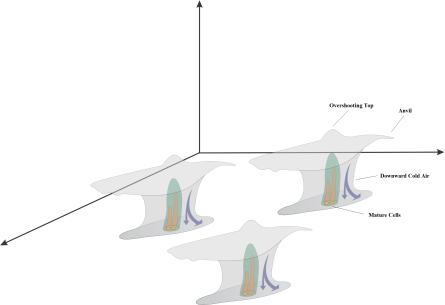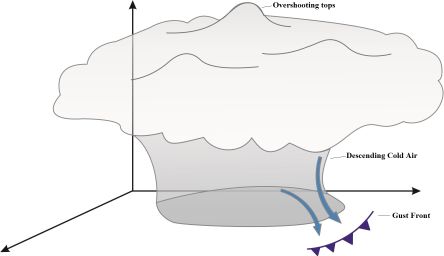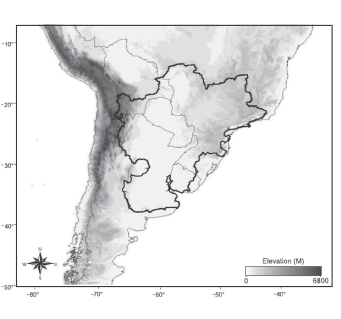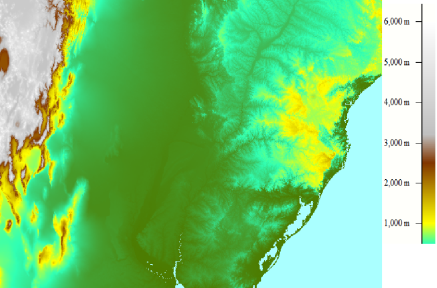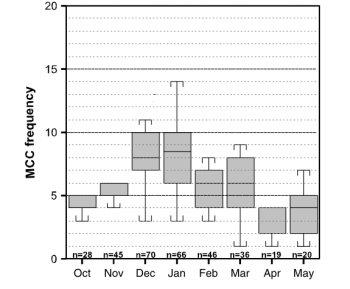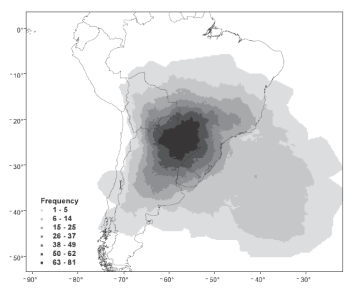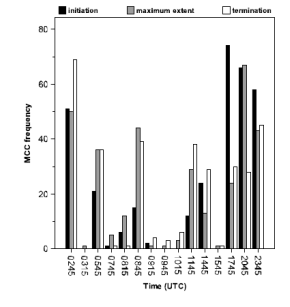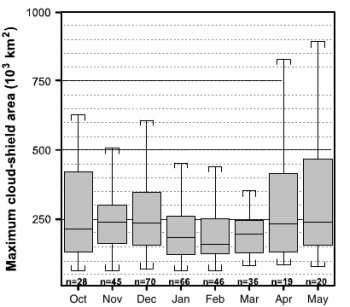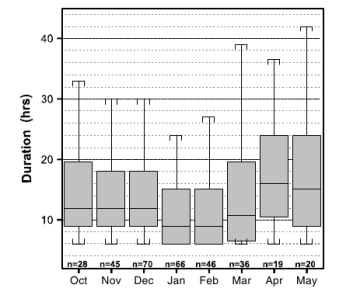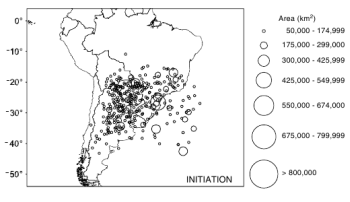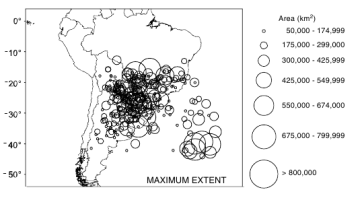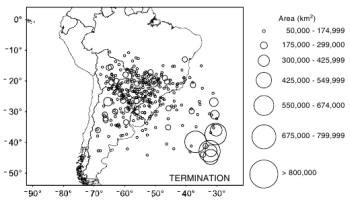Meteorological Physical Background
Introduction
This conceptual model describes the MCC over Subtropical South America (SSA).
Mesoscale Convective Complexes (MCC) are a subset of Mesoscale Convective Systems (MCS). Seen from a satellite it is a large (100 km in at least one direction), roughly circular cloud shield. MCC may include squall lines, bow echoes and/or isolated convective cells, each of which have their own life cycles. Though isolated from one another, together they form a larger cloud system with an expanding cold pool and common cloud top shield (anvil).
The following table shows the criteria by which MCC are defined.
| Criteria | Features |
|---|---|
| Size: A | for the whole cloud shield (A): cloud top temperature <= -32°C, cloud shield area >= 100 000 km2 |
| Size: B | for the interior (B): cloud top temperature <= -52°C, cloud shield area >= 50 000 km° |
| Initiate | size definitions A and B are satisfied |
| Duration | size definitions A and B last at least 6 hours |
| Maximum extent | cloud shield satisfying temperature definition reaches ist maximum size |
| Shape | Eccentricity (minor axis/major axis) >= 0.7 at the phase of maximum size |
| Dissipation | size definitions A and B are no longer satisfied |
Broad Overview
MCC has typically four stages: initiation, development, mature stage and dissipation.
1. Initiation
This phase may include squall lines, bow echoes and isolated convective cells each having their own life cycle. Each system contributes to the expanding cold pool and anvil.
The following environmental features are favorable for MCC development:
- prominent baroclinic zones characterized by locally large values of lower tropospheric vertical wind shear and CAPE
- low-level jet oriented nearly perpendicular to the baroclinic zone
- pronounced warm advection and low-level winds with strong vertical veer
- local maximum of absolute humidity
- low-level convergence and upper-level divergence
- approaching weak mid-level trough with a weak vorticity maximum
- in most instances, an upper-level jet
- low-level warm temperature advection together with cyclonic vorticity advection increasing with height throughout the troposphere, causing maximum upward motion maximum at the mid-levels.
|
Initiation of a MCC: isolated convective cells near each other.
|
2. Development
Convergence of warm air and moisture in the lower levels feeds the convection process.
3. Mature stage
Convective elements continue to sustain the system's activity.
|
Mature stage of a MCC: nearly circular cluster of convective storms. Descending cold air creates gust fronts around the cluster, especially ahead of it.
|
4. Dissipation
Convection ceases.

|
Press "Play Button" for stages of MCC that occurred in 19th October 2009
Stages: Genesis (Initial Storms), Development, Mature and Dissipation |
Geographical Location
SSA consists of southern Bolivia, southern Brazil, Paraguay, northern Argentina, and Uruguay. It is home to the world's fifth largest river basin, the La Plata Basin (image on the left). Some of the world's most intense thunderstorm complexes (e.g. mesoscale convective complexes (MCC) and mesoscale convective systems (MCS) are found there. MCC precipitation measurements help to estimate the hydroclimate of the La Plata Basin. The MCC generally form around 20°S - 35°S and 70°W - 45°W.
|
Topographical map of SSA. The perimeter of the La Plata Basin is outlined.
|
Topographical map of the region where MCC's tend to form. Location between 20°S - 35°S and 70°W - 45°W.
|
Seasonal variety
The images below provide MCC frequencies for the austral warm season (defined as October-May) for 1998-2007 by Durkee and Mote (2009). The image on the left shows that the highest frequencies occur in December and January. For the period in question, 70 events were recorded in December and 66 in January. The figure on the right depicts the areas of MCC occurence frequency. The gray shades represent the number of cases when grid points were located within a MCC storm track. Northeastern Argentina, Paraguay and southwestern Brazil are the regions with most observations of MCC.
|
Box-and-whisker plot of warm season MCC frequency by month for the years 1998-2007. The boxes show the interquartile range, the whiskers show the 10th and 90th percentiles and the solid line indicates the median. 'n' is equal to the number of events for a given month.
|
MCC frequency during the warm season (October-May) for 1998-2007 (N=330), determined by the number of cases when grid points were located within an MCC storm track.
|
Regional characteristics
MCC initiation generally occurs in the late afternoon or early evening. The systems reach maximum size around midnight before dissipating the next morning.
The average duration for all events was 14 h. The highest precipitation rates are most likely to occur between initiation and maximum extent, while the greatest amount of precipitation occurs near the maximum extent.
The greatest frequency of occurrence (nearly 75% of cases) for initiation, maximum extent, and termination were observed at 17:45, 20:45, and 02:45 UTC, respectively.
The average size of all 330 MCC at maximum extent was 256 500 km2 (by maximum cloud shield size). The largest MCC occurred in late spring, early summer and late fall, while the smallest systems occurred during late summer.
For the most part, the MCC ran their course (initiation, maximum extent and termination) inside 20°S - 30°S.
|
Frequency of MCCs during initiation, maximum size, and termination stages.
|
Frequency of maximum cloud top shield size.
|
|
MCC life cycle duration by month.
|
MCC cloud shields during the initiation stage, observed during the warm season months of October-May during 1998-2007.
|
|
MCC cloud shields at maximum extent, observed during the warm season months of October-May during 1998-2007.
|
MCC cloud shields in the termination stage, observed during the warm season months of October-May during 1998-2007.
|
